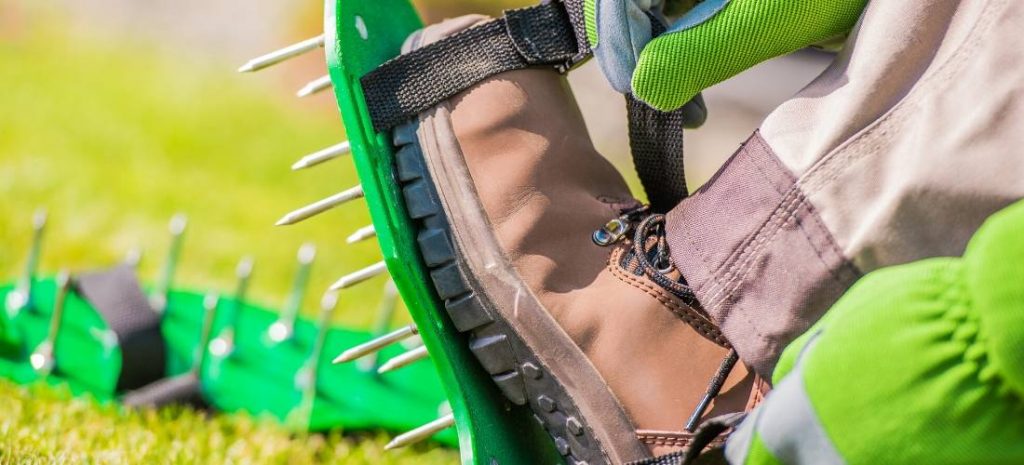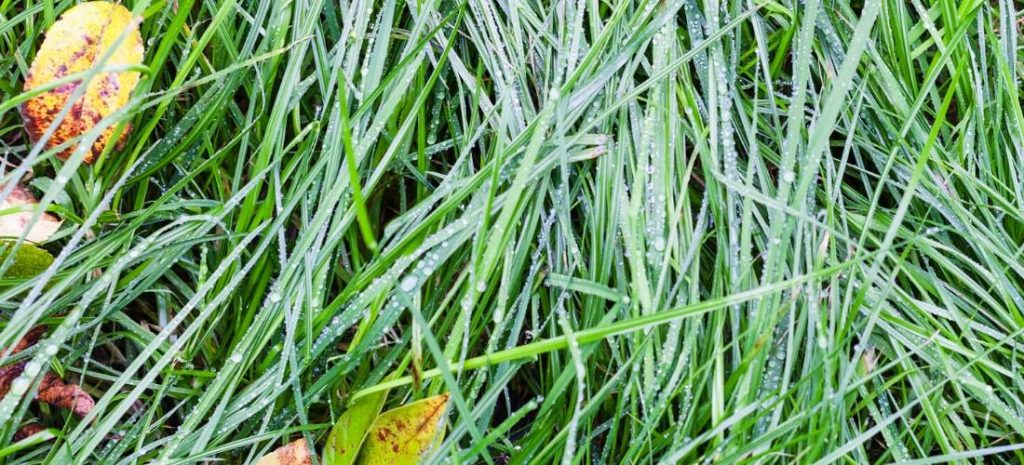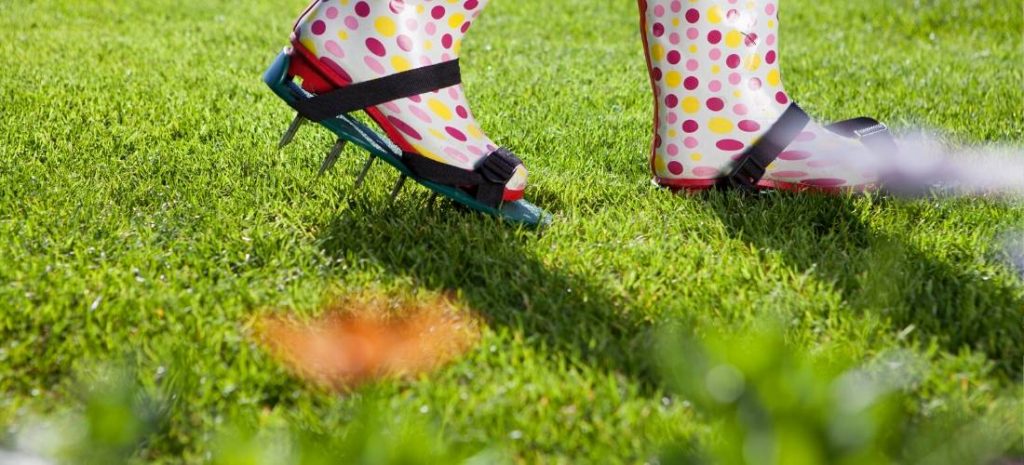Keeping a gorgeous green lawn is the pride of many a veteran suburbanite; some people have found a way to make the patch of grass in front of their house so saturated with lovely emerald shades that they almost seem fake—but they are very real.
To get this effect, these homeowners must pay great attention to their lawns to keep their grass thick and deeply rooted, a combination that results in the beautiful full-colour that healthy grass gives you. One of the most important things you can do to take good care of your lawn is to aerate it, or de-compact it, correctly.
Thankfully for all budding green thumbs and lawncare beginners, our Beginner’s Guide to Aerating Your Lawn contains all the information you’ll need to get your lawn aerated. Soon enough, you’ll have the prettiest deep green grass on the street!
In This Guide
What Is Lawn Aeration?
Lawn aeration is one of the most helpful endeavours you can undertake if you’re looking to keep your grass strong and healthy. The process involves inserting small holes in the ground which provide air circulation and improved water and nutrient consumption for the roots of your grass.

Get your boots on!
In this case, air circulation means allowing stale carbon dioxide to leave the soil to make room for fresh oxygen to take its place.
For more high maintenance patches, the aeration process breaks through the thatch layer of interwoven dead and living stems, roots, and leaves that grow between your grass and the soil feeding it underneath.
This allows for the grass and the nutrient-rich soil to resume their symbiotic relationship without the problems and issues that thatching causes.
Some soil is naturally very compactable because of how many solid soil particles there are in such a small space. Aeration works to separate those particles, which are helping to block the roots’ access to nutrients, air, and water.
If your garden is anything like mine and you’re unfortunate enough to have soil with high levels of clay, then regular aeration is an absolute must!
Do You Really Need To Aerate Your Lawn?
All lawns are not created equal, so different turfs need different levels of care and aeration to stay in tip-top shape. If you want to have a decent looking patch, this process really can’t be ignored.
Lawn aeration improves the overall health of your grass by giving the root zone better access to essentials such as air, water, and fertiliser. This increased health helps the grass grow a more robust and more extensive network of roots.
Thatching is a particularly sore point for lawn-owners that aeration helps with, as the action brings thatch-decomposing micro-organisms from deep in the soil up to the top layer.
Aeration also helps to relieve soil compaction, which can cause dead patches and thinning in your lawn. Tightly packed soil stops the nutrients that roots need from reaching them, a problem which aeration solves by removing cores, which lowers soil density.
Aerating before and after seeding can also help the process along by creating a moist, protected environment for the little seedlings. Puddling and flooding is another problem to which you can bid farewell with aeration, as the action allows for much more drainage within your patch.
When Should I Aerate My Lawn?
For those living in the rolling hills of the UK, the ideal time to aerate your lawn is spring or autumn. This is because these seasons usually allow for the most naturally moist soil, which is a crucial component needed for effective hole-setting.
Spring, when the grass has just started to grow again, is especially suitable for aeration, as this season gives grass ample opportunity to heal correctly. That said, the weather is fickle in the British Isles, and aeration is dependent on weather conditions more than anything else.
If the soil is soaked, then the holes will not allow water and air to pass through because the holes seal up more quickly. It won’t do well to try aerating soil that’s too dry either, which is why the natural moist of spring is so ideal.

When it comes to the frequency with which you should be aerating your lawn, that all depends on the grass itself. Newer lawns need more aeration because their root systems are less than mature, a process which is boosted by regular aeration. If you have a new non-established lawn, it’s prudent to aerate twice a year.
Harder clay soils also needed to be aerated at least annually because of the difficulty with which this type of soil absorbs air and water for its roots.
All other kinds of soil need aeration only once every three years, though be sure to keep an eye on your lawn, as unhealthy, growth-stunted grass is usually a sign that it needs aeration.
The tool you use is also an essential factor to consider when deciding on your intended aeration intervals. If you’re aerating between March and November, you can use any aerator you please to aerate your turf, from rolling lawn to garden fork.
Always avoid aerating when there’s an imminent frost or if your soil is exceedingly wet. Otherwise, you may end up with your aerator stuck in the mud and cause damage to your lawn.
For drier days, shallow spiking or pricking is the aeration method of choice, as the spikes won’t penetrate too far. This will allow for even the slightest drizzles to get into your soil and give it the nourishment it needs.
If you’re coring using a hollow tine aerator, which is one of the more invasive ways to get the job done, you should be sure that the patch will have enough time to recover from the process.
August to about mid-October is the ideal time to aerate your lawn this way, as the weather is on its way to being wetter, not drier. Aeration increases drainage and soil temperatures, which is precisely what the botanist ordered for this time of year.
Always be sure there are no imminent temperature drops on their way, as a lawn freezing over shortly after hollow tining can cause the whole patch to heave up.
How Do I Aerate My Lawn (How To Use A Lawn Aerator)?
Before getting out there and aerating, you need to be sure that the soil is relatively moist, so either water the lawn before or plan to aerate the day after it rains. Mowing the lawn beforehand doesn’t hurt either.
Hand aerators are some of the cheapest aerating options available and are perfect for smaller lawns and gardens. Pitchforks can do the job, or you can use a hollow tine aerator, which removes a plug of soil as it goes which helps to prevent the hole from quickly closing again.
Machine aerators are very good at what they do, but they come at a premium price. The smaller ones work well for small and medium-sized lawns and gardens and are used similarly as old-time lawnmowers. The bigger machines are truly massive, as they must be pulled by a tractor to take care of enormous lawns and fields.
When doing the actual aerating, it’s important to focus your attention on the areas of your lawn with the most issues; there’s no point in wasting your time and energy going over healthy grass several times. Problem areas, on the other hand, need to be gone over several times with the aerator. Be sure to do your aerating in an organised manner as well, similar to how you mow the lawn.
After you’ve finished aerating, consider applying your fertiliser to accelerate the turf’s recovery into a thick and healthy lawn.
Do Aerator Shoes Really Work or Are They a Gimmick?
While they admittedly seem like a novel idea, aerator shoes cannot replace a real lawn aerator. The spike-soled shoes look like a fun enough fad, but they won’t get the job done, and they are likely to bring about the opposite of the desired effect on your lawn.

The gist of it is that human feet are just too small. A shoe doesn’t impact enough space on the ground to make a difference truly, and the spikes on the shoes can serve to compact your already suffering soil further.
Because the spikes on the soles of these seemingly ingenious shoes are solid instead of hollow, they more often push the soil sideways or downwards when they’re in the ground, which compacts the ground even more.
While they’re not great for large lawns, aerator shoes can be a nifty tool for smaller gardens in need of aeration. The one to one and a half-inch spikes of the shoes work well in small patches, though you must think about where you’re walking when wearing them in your garden. These shoes could easily wreak havoc on a small yard if not used in an organised fashion.
Final Thoughts
Now that you know what aeration is, all the benefits it can bring to your lawn, and exactly how to go about your aerating, you’re ready to graduate from beginner to pro. Follow our tips and info, and soon you’ll have the greenest lawn in all the land!






